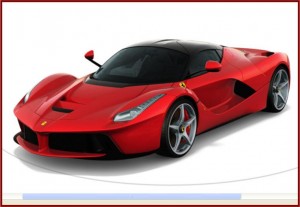
Unlike typical hybrids, LaFerrari’s €1 million price will not be an issue with what looks to be an instant classic.
Ferrari has revealed a limited edition super car that has an 800 horsepower V12 engine, a F1 derived dual clutch gearbox and a hybrid system capable of adding 163 horsepower to the output with an electric motor.
LaFerrari promises to be the most sophisticated GT car with the highest performance ever achieved by a Ferrari. Zero-to-60 mph times of less than 3 seconds and a top speed of more than 350 km/h are claimed. The Fiat-owned company said the technical systems would be incorporated in the rest of the Ferrari range over time. For the moment, only 499 wealthy customers will be able to buy the €1 million car, Ferrari’s first hybrid.
Porsche AG’s 918 hybrid Spyder is now on sale for €645,000 – $928,000, gulp – plus value added tax and other country specific charges. Deliveries of the evolved version of the concept 918 hybrid that debuted in Geneva in 2010 will begin in November of 2013, with production in the Stuttgart suburb of Zuffenhausen scheduled for this September. Production of the two-seat hybrid sports car will be limited to 918 units, which sets up a sales race for customers between the two famous brands. How many of these expensive hybrids can be sold? The 918’s V8 engine delivers more than 368 kW or 500 horsepower. This is increased by two electric motors with at least 160 kW (218 hp). Fuel consumption of 918 Spyder is estimated at three liters of fuel per 100 kilometers (~ 74 mpg) based on the New European Driving Cycle (NEDC).
While the European economy is in shambles with depression levels of unemployment in southern states, and auto sales in decline for six straight years, Ferrari posted a €244 million profit for 2012, its best year in history. Chairman Luca di Montezemolo characterized the business conditions in Italy as “distinctly hostile” where Fiat remains the largest private sector employer. Nevertheless, 7,318 road cars were delivered to dealers (+4.5% on 2011) with revenues of €2.433 billion, an increase of 8% from 2011. Record sales were recorded in the U.S., China, Germany and Great Britain.
Ferrari said that one of the greatest challenges in designing the LaFerrari model was fitting the hybrid system into a two-seat sports car. Despite having the same wheelbase and maximum overall length as the Enzo, the LaFerrari has the typical hybrid problem of incorporating two methods of propulsion along with an expensive lithium-ion battery pack, plus the cooling systems for all three. The high levels of torque available at low speeds from the electric motor allowed the engineers to calibrate the V12 gasoline engine for higher performance at higher engine speeds. The stated maximum torque peak is more than 900 Nm. The V12’s peak torque of 700 Nm is developed at 6750 rpm. Unlike typical hybrids now on sale, LaFerrari’s €1 million price will not be an issue with what looks to be an instant classic.
The electric motor (120 Kw) is claimed to have performance figures comparable to those of the Ferrari F1 car with the same torque density and the same efficiency of 94%. Battery size was an essential factor in optimizing the so-called HY-KERS systems’ power-to-weight ratio with the goal being to maximizing performance while reducing fuel consumption. A complex setup consisting of 120 cells assembled into eight 15-cell modules has a power output that is the equivalent of 40 traditional batteries but weighing just 60 kg.
The high-voltage batteries are assembled in-house by the Scuderia racing department. The batteries are charged in two different ways: under braking – even hard braking when the ABS intervenes, such as when driving on a track – and every time the V12 produces more torque than required, such as in cornering. In the latter case, rather than the being sent to the wheels, the excess torque is converted to energy and stored in the batteries.
The HY-KERS system is governed by the Hybrid Power Unit that controls the power delivery from both the V12 and the electric motor via two inverters and two DC-DC converters. The variable-frequency control is said to decrease response time. C02 emissions have been reduced to 330 g/km without resorting to electric-only drive. The HY-KERS system is designed, however, for future applications where a car can be driven using only electric power for a few kilometers. During development testing, this full-electric version of LaFerrari produced just 220 g/km of C02 emissions on the combined European cycle.
There are stringent EU proposals to reduce CO2 output to 95 grams per kilometer by 2020 for the European new car fleet, which means a fuel consumption of less than 4 liters – across all segments and vehicle classes.



